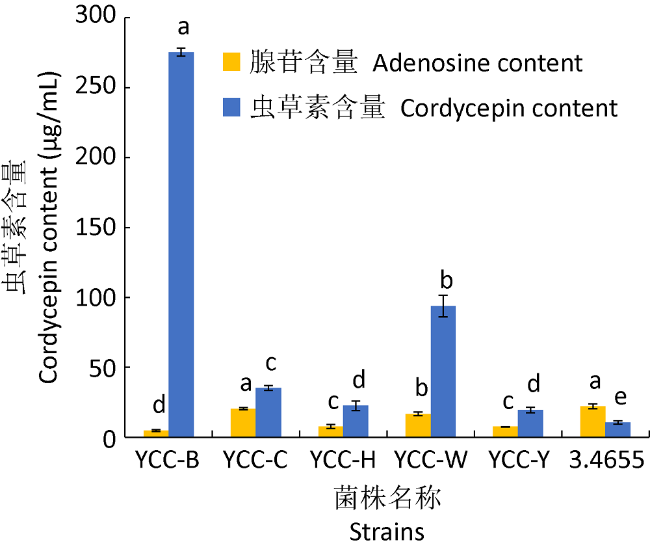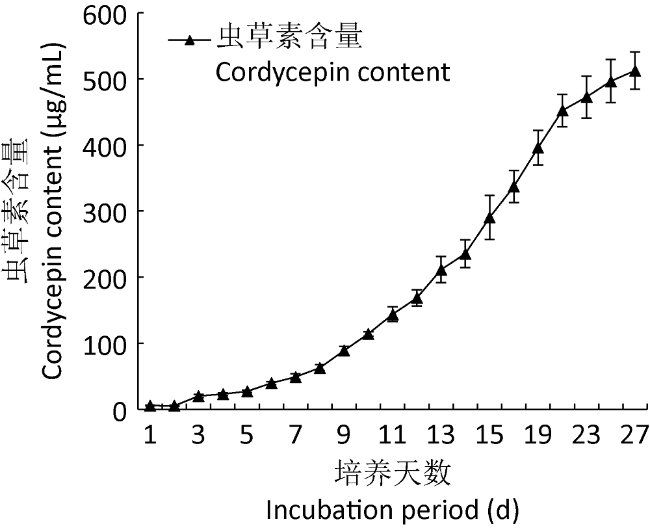 PDF(747 KB)
PDF(747 KB)


 PDF(747 KB)
PDF(747 KB)
 PDF(747 KB)
PDF(747 KB)
优良性状蚕蛹虫草的筛选及高产虫草素液态发酵条件优化
Screening of Cordyceps militaris with excellent traits and optimization of liquid fermentation conditions for highly yielding cordycepin
 ,
,  ({{custom_author.role_en}}), {{javascript:window.custom_author_en_index++;}}
({{custom_author.role_en}}), {{javascript:window.custom_author_en_index++;}}蛹虫草是重要的食药用真菌,虫草素为其主要活性成分,在抗肿瘤、抗菌、降血糖等方面具有较为突出的功效。蛹虫草菌株间的形态及环境条件差异,对菌株次级代谢产物虫草素产生影响显著。本研究对不同来源的6株蛹虫草菌株(YCC-B、YCC-C、YCC-H、YCC-W、YCC-Y、CGMCC 3.4655),从蚕蛹体培养子实体性状,液体发酵条件(培养天数、培养方式、外源金属离子等)和传代稳定性等方面筛选优良性状菌株,提高其发酵合成虫草素的能力及稳定性。结果表明,蛹虫草菌株YCC-W在蚕蛹子实体出草及菌体液体发酵产虫草素上综合表现优良,传代稳定;液体发酵培养基中添加外源金属离子Mn2+作为酶的辅基,可以促进虫草素合成;采用振荡-静置相结合的混合发酵培养方式,可以避免单纯振荡培养溶氧量大、菌丝体生长旺盛,而虫草素产生不佳的问题。先振荡培养3d后静置培养至25d时,菌株YCC-W合成虫草素含量最高,可达(874.13±24.25)μg/mL,且稳定性良好。为进一步开发菌种及扩大规模生产提供参考。
Cordyceps militaris is an important edible and medicinal fungus, having active ingredient with outstanding effects in anti-tumor, anti-bacteria, reducing blood sugar and other functions. The differences of morphological characters and growth environment of C. militaris strains significantly influence the production of secondary metabolites. In this study, six strains of C. militaris (YCC-B, YCC-C, YCC-H, YCC-W, YCC-Y and CGMCC 3.4655) from different sources were selected based on properties of stromata on tussah pupae, liquid fermentation conditions (culture duration, culture methods, exogenous metal ions, etc.) and reproduction stability for screening the most excellent strain to improve ability and stability of fermentation and synthesis of cordycepin. The results showed that C. militaris YCC-W fruiting body properties performed well on tussah pupae and cordycepin production was promoted in liquid fermentation, showing stable reproduction in subculture. The synthesis of cordycepin was greatly improved by adding the metal ion Mn2+ to the liquid fermentation medium as a coenzyme. The mixed culture method (shaking + standing) can avoid the poor production of cordycepin caused by the strong growth of mycelium with large dissolved oxygen in the simple shaking culture. On the conditions of 3d shake culture proceeded with 22d static culture, production of cordycepin of strain YCC-W reached the highest yield of (874.13±24.25)μg/mL. The results provide reference for further development of the strains and expanding cordycepin production.

金属离子 / 活性产物 / 腺苷 / 传代培养 {{custom_keyword}} /
metal ions / active product / adenosine / subculture {{custom_keyword}} /

图3 蛹虫草菌株发酵液中腺苷和虫草素含量相同字母表示采用“Tukey test”检验,组间没有显著差异(P>0.05),不同字母表示有显著差异(P<0.05). 下同 Fig. 3 Content of adenosine and cordycepin in fermentation broth of different strains of Cordyceps militaris. The same letter indicated “Tukey test”, and there was no significant difference between groups (P>0.05), while different letters indicated significant difference (P<0.05). The same below. |

图4 传代次数对YCC-B和YCC-W菌株合成虫草素的影响Fig. 4 The content of synthetic cordycepin of Cordyceps militaris YCC-B and YCC-W in different generation of subculture. |

图6 YCC-W菌株液体培养1-27d虫草素的含量Fig. 6 Content of cordycepin in the strain YCC-W incubated in liquid culture for 1-27d. |
表1 YCC-W菌株每日虫草素的含量(n=3, |
| 培养天数 Culture time (d) | 虫草素含量 Cordycepin content (μg/mL) | 培养天数 Culture time (d) | 虫草素含量 Cordycepin content (μg/mL) | ||
|---|---|---|---|---|---|
| 1 | 5.50±0.63 n | 12 | 168.60±12.30 h | ||
| 2 | 5.37±0.72 n | 13 | 211.37±19.75 g | ||
| 3 | 20.09±2.43 mn | 14 | 235.51±20.84 g | ||
| 4 | 23.04±2.13 mn | 15 | 290.30±33.27 f | ||
| 5 | 27.26±1.72 lmn | 17 | 337.05±24.48 e | ||
| 6 | 39.69±2.19 lmn | 19 | 395.83±25.94 d | ||
| 7 | 48.97±4.46 lm | 21 | 452.00±24.72 bc | ||
| 8 | 62.82±4.52 kl | 23 | 472.53±31.81 bc | ||
| 9 | 88.89±6.34 jk | 25 | 496.43±32.56 ab | ||
| 10 | 114.14±3.34 ij | 27 | 512.63±28.24 a | ||
| 11 | 143.76±11.14 hi | ||||
| 注:数值表示为平均值±标准差;不同小写字母表示在P<0.05时具有显著差异 | |
| Note: Values are expressed as mean ± standard deviation; different lowercase letters indicate significant differences at P<0.05. |
| [1] |
{{custom_citation.content}}
{{custom_citation.annotation}}
|
| [2] |
{{custom_citation.content}}
{{custom_citation.annotation}}
|
| [3] |
{{custom_citation.content}}
{{custom_citation.annotation}}
|
| [4] |
{{custom_citation.content}}
{{custom_citation.annotation}}
|
| [5] |
{{custom_citation.content}}
{{custom_citation.annotation}}
|
| [6] |
{{custom_citation.content}}
{{custom_citation.annotation}}
|
| [7] |
{{custom_citation.content}}
{{custom_citation.annotation}}
|
| [8] |
The biosynthesis of 3'-deoxyadenosine (cordycepin) by Cordyceps militaris has been investigated using [U-14C]adenosine and [3-3H]ribose. Crystallization of the resulting radioactive 3'-deoxyadenosine to a constant specific activity showed incorporation of both labeled compounds. A control showed that the 3H:14C ratio of the AMP isolated from the RNA was the same as the 3H:14C ratio in the 3'-deoxyadenosine. The 14C ratio in the adenine: ribose of the [U-14C]adenosine added to the 3'-deoxyadenosine producing cultures of C. militaris and of the isolated 3'-deoxyadenosine was the same, e.g. 50:50. These data provide strong evidence that adenosine in converted to 3'-deoxyadenosine without hydrolysis of the N-riboside bond. Degradation of the 3-deoxyribose from 3'-deoxyadenosine showed that the 3H was retained on carbon-3. These results suggest that the formation of 3'-deoxyadenosine may proceed by a reductive mechanism similar to that for the formation of 2'-deoxynucleotides.
{{custom_citation.content}}
{{custom_citation.annotation}}
|
| [9] |
{{custom_citation.content}}
{{custom_citation.annotation}}
|
| [10] |
{{custom_citation.content}}
{{custom_citation.annotation}}
|
| [11] |
{{custom_citation.content}}
{{custom_citation.annotation}}
|
| [12] |
{{custom_citation.content}}
{{custom_citation.annotation}}
|
| [13] |
{{custom_citation.content}}
{{custom_citation.annotation}}
|
| [14] |
{{custom_citation.content}}
{{custom_citation.annotation}}
|
| [15] |
{{custom_citation.content}}
{{custom_citation.annotation}}
|
| [16] |
{{custom_citation.content}}
{{custom_citation.annotation}}
|
| [17] |
is an entomopathogenic fungus which is often used in Asia as a traditional medicine developed from age-old wisdom. Presently, cordycepin from is a great interest in medicinal applications. However, cellular growth of and the association with cordycepin production remain poorly understood. To explore the metabolism of as potential cell factories in medical and biotechnology applications, this study developed a high-quality genome-scale metabolic model of, NR1329, based on its genomic content and physiological data. The model included a total of 1329 genes, 1821 biochemical reactions, and 1171 metabolites among 4 different cellular compartments. Its growth simulation results agreed well with experimental data on different carbon sources. NR1329 was further used for optimizing the growth and cordycepin overproduction using a novel approach, POPCORN, for rational design of synthetic media. In addition to the high-quality GEM NR1329, the presented POPCORN approach was successfully used to rationally design an optimal synthetic medium with C:N ratio of 8:1 for enhancing 3.5-fold increase in cordycepin production. This study thus provides a novel insight into physiology and highlights a potential GEM-driven method for synthetic media design and metabolic engineering application. The NR1329 and the POPCORN approach are available at the GitHub repository: https://github.com/sysbiomics/-GEM.© 2019 The Authors.
{{custom_citation.content}}
{{custom_citation.annotation}}
|
| [18] |
{{custom_citation.content}}
{{custom_citation.annotation}}
|
| [19] |
{{custom_citation.content}}
{{custom_citation.annotation}}
|
| [20] |
{{custom_citation.content}}
{{custom_citation.annotation}}
|
| [21] |
{{custom_citation.content}}
{{custom_citation.annotation}}
|
| [22] |
{{custom_citation.content}}
{{custom_citation.annotation}}
|
| [23] |
{{custom_citation.content}}
{{custom_citation.annotation}}
|
| [24] |
{{custom_citation.content}}
{{custom_citation.annotation}}
|
| [25] |
{{custom_citation.content}}
{{custom_citation.annotation}}
|
| [26] |
{{custom_citation.content}}
{{custom_citation.annotation}}
|
| [27] |
{{custom_citation.content}}
{{custom_citation.annotation}}
|
| [28] |
{{custom_citation.content}}
{{custom_citation.annotation}}
|
| [29] |
{{custom_citation.content}}
{{custom_citation.annotation}}
|
| [30] |
{{custom_citation.content}}
{{custom_citation.annotation}}
|
| [31] |
陈丽冰, 吴光旭, 程薇, 范秀芝, 史德芳, 石猛, 高虹, 2016. 北虫草培养残基中虫草素的提取纯化及抗肿瘤活性. 食品科学技术学报, 34(4):73-79
{{custom_citation.content}}
{{custom_citation.annotation}}
|
| [32] |
董宏鸿, 李建军, 周行, 姜艳霞, 2016. 蛹虫草中虫草素的提取及药理活性研究进展. 吉林医药学院学报, 37(6):465-467
{{custom_citation.content}}
{{custom_citation.annotation}}
|
| [33] |
李兵, 2016. 蛹虫草中虫草素和腺苷的提取分离及其对糖尿病小鼠肾脏氧化应激的影响. 合肥工业大学硕士论文,合肥. 1-73
{{custom_citation.content}}
{{custom_citation.annotation}}
|
| [34] |
李晖, 孙佳瑜, 廖康汉, 王喆, 单爱云, 2016. 虫草素抗炎作用及机制研究. 天津中医药, 33(5):303-306
{{custom_citation.content}}
{{custom_citation.annotation}}
|
| [35] |
罗巍, 刘东波, 吴郑武, 夏志兰, 谢红旗, 2011. 蛹虫草液态发酵过程中有效成分的动态积累变化. 食品与发酵工业, 37(10):96-99
{{custom_citation.content}}
{{custom_citation.annotation}}
|
| [36] |
刘希文, 汤佳鹏, 2021. 蛹虫草丝瓜络半固态发酵产虫草素的工艺优化. 食品工业科技, 42(6):118-124
{{custom_citation.content}}
{{custom_citation.annotation}}
|
| [37] |
马婕馨, 2020. 蛹虫草液体发酵虫草素纯化及抗菌抑癌活性分析. 北京林业大学硕士论文,北京. 91
{{custom_citation.content}}
{{custom_citation.annotation}}
|
| [38] |
孟小丽, 李翠新, 2017. 蛹虫草菌种退化的检测方法和影响因素. 安徽农业科学, 45(13): 133-134+156
{{custom_citation.content}}
{{custom_citation.annotation}}
|
| [39] |
宁宝云, 薛姗姗, 刘慧, 刘康, 郝继伟, 2020. 蛹虫草菌种复壮方法探讨. 食用菌, 42(3): 24-26+28
{{custom_citation.content}}
{{custom_citation.annotation}}
|
| [40] |
王长文, 王忠, 王锦锋, 吴鸿雪, 2019. 蛹虫草虫草素研究进展. 福建农业科技, 50(2):66-70
{{custom_citation.content}}
{{custom_citation.annotation}}
|
| [41] |
王延明, 2013. 九州虫草基因组改组育种与体外抗氧化活性研究. 山东大学硕士论文,济南. 1-101
{{custom_citation.content}}
{{custom_citation.annotation}}
|
| {{custom_ref.label}} |
{{custom_citation.content}}
{{custom_citation.annotation}}
|
 PDF(747 KB)
PDF(747 KB)
 图1 蛹虫草不同菌株接种虫蛹体培养情况
图1 蛹虫草不同菌株接种虫蛹体培养情况 图2 标准品腺苷和虫草素高效液相色谱峰
图2 标准品腺苷和虫草素高效液相色谱峰 图3 蛹虫草菌株发酵液中腺苷和虫草素含量
图3 蛹虫草菌株发酵液中腺苷和虫草素含量 图4 传代次数对YCC-B和YCC-W菌株合成虫草素的影响
图4 传代次数对YCC-B和YCC-W菌株合成虫草素的影响 图5 YCC-W发酵液中腺苷和虫草素高效液相色谱峰
图5 YCC-W发酵液中腺苷和虫草素高效液相色谱峰 图6 YCC-W菌株液体培养1-27d虫草素的含量
图6 YCC-W菌株液体培养1-27d虫草素的含量 表1 YCC-W菌株每日虫草素的含量(n=3,
表1 YCC-W菌株每日虫草素的含量(n=3, 图7 不同培养方式对YCC-W菌株合成虫草素的影响
图7 不同培养方式对YCC-W菌株合成虫草素的影响 图8 添加不同金属离子YCC-W菌体液体发酵表观情况(25d)
图8 添加不同金属离子YCC-W菌体液体发酵表观情况(25d) 图9 金属离子添加对YCC-W虫草素含量的影响
图9 金属离子添加对YCC-W虫草素含量的影响/
| 〈 |
|
〉 |